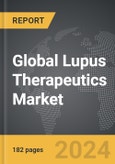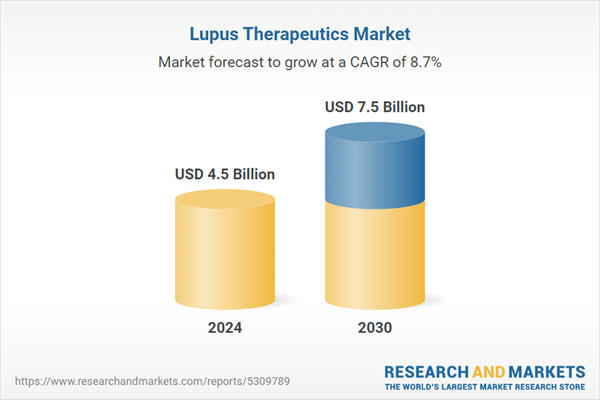Global Lupus Therapeutics Market - Key Trends & Drivers Summarized
What Challenges and Opportunities Exist in Lupus Treatment Today?
Lupus, a chronic autoimmune disease characterized by the immune system attacking its own tissues, presents significant treatment challenges due to its complex and varied symptoms, ranging from mild skin rashes to severe kidney damage. Traditional lupus therapies have largely revolved around non-specific immunosuppressants, such as corticosteroids and antimalarial drugs, which can have wide-ranging side effects and vary in effectiveness. However, the growing understanding of the disease's underlying biological pathways has opened up opportunities for targeted therapies, which aim to modulate specific immune system components without broad immunosuppression. These advancements represent a shift towards more personalized medicine in lupus treatment, focusing on patient-specific disease manifestations and genetic profiles, improving both treatment efficacy and quality of life for patients.How Are New Technologies Revolutionizing Lupus Treatment?
The integration of biotechnology and pharmacological advancements has begun to revolutionize lupus treatment. The development of biologic drugs, specifically designed to target particular immune system molecules, has provided new hope for patients who do not respond to conventional therapies. For instance, monoclonal antibodies that inhibit immune system proteins, which are pivotal in the development of inflammation, have shown promise in reducing the severity of lupus symptoms. Additionally, advancements in genomics have facilitated the identification of genetic markers associated with the disease, potentially leading to earlier diagnosis and more tailored treatment strategies. These technological innovations not only enhance the precision of lupus therapies but also help in reducing the occurrence of severe side effects that are often associated with traditional treatment options.What Impact Does Patient Advocacy and Awareness Have on the Lupus Therapeutics Market?
Increased awareness and patient advocacy are playing critical roles in transforming the lupus therapeutics market. Enhanced public and medical understanding of lupus, driven by patient advocacy groups, has led to earlier diagnosis and treatment interventions, which are crucial in managing the disease effectively. These groups have also been instrumental in pushing for more research funding and better healthcare policies that support the development and accessibility of new therapies. Additionally, the global rise in health literacy has empowered patients to actively participate in their treatment decisions, increasing demand for newer, less toxic, and more effective medications. This shift towards patient-centered care in the lupus therapeutics market is not only improving outcomes but is also influencing drug development priorities and healthcare practices.Growth in the Lupus Therapeutics Market Is Driven by Several Factors
The growth in the lupus therapeutics market is driven by several factors, including advances in medical research that enhance understanding of the disease, developments in genetic testing, and the introduction of novel medications. Increased investment in research and development has led to the emergence of new drugs that target specific pathways involved in the immune response, offering alternatives to traditional treatments with fewer side effects. Furthermore, regulatory support for drug development, such as the FDA's fast track and breakthrough therapy designations, accelerates the approval process for promising lupus treatments, enhancing their commercial viability and market entry. The growing patient advocacy for better healthcare solutions also stimulates demand for innovative treatments, ensuring continued investment and interest in this field. Together, these dynamics underscore a market geared towards extensive growth and transformation, promising a new era of options for lupus management.Report Scope
The report analyzes the Lupus Therapeutics market, presented in terms of market value (USD). The analysis covers the key segments and geographic regions outlined below.- Segments: Drug Class (Anti-Inflammatory Drugs, Corticosteroids, Immunosuppressant Drugs, Antimalarial Drugs, BLyS-Specific Inhibitors, Biologicals, Other Drug Classes).
- Geographic Regions/Countries: World; United States; Canada; Japan; China; Europe (France; Germany; Italy; United Kingdom; and Rest of Europe); Asia-Pacific; Rest of World.
Key Insights:
- Market Growth: Understand the significant growth trajectory of the Anti-Inflammatory Drugs segment, which is expected to reach US$2.7 Billion by 2030 with a CAGR of 8.1%. The Corticosteroids segment is also set to grow at 8.3% CAGR over the analysis period.
- Regional Analysis: Gain insights into the U.S. market, valued at $1.3 Billion in 2024, and China, forecasted to grow at an impressive 8.2% CAGR to reach $1.2 Billion by 2030. Discover growth trends in other key regions, including Japan, Canada, Germany, and the Asia-Pacific.
Why You Should Buy This Report:
- Detailed Market Analysis: Access a thorough analysis of the Global Lupus Therapeutics Market, covering all major geographic regions and market segments.
- Competitive Insights: Get an overview of the competitive landscape, including the market presence of major players across different geographies.
- Future Trends and Drivers: Understand the key trends and drivers shaping the future of the Global Lupus Therapeutics Market.
- Actionable Insights: Benefit from actionable insights that can help you identify new revenue opportunities and make strategic business decisions.
Key Questions Answered:
- How is the Global Lupus Therapeutics Market expected to evolve by 2030?
- What are the main drivers and restraints affecting the market?
- Which market segments will grow the most over the forecast period?
- How will market shares for different regions and segments change by 2030?
- Who are the leading players in the market, and what are their prospects?
Report Features:
- Comprehensive Market Data: Independent analysis of annual sales and market forecasts in US$ Million from 2024 to 2030.
- In-Depth Regional Analysis: Detailed insights into key markets, including the U.S., China, Japan, Canada, Europe, Asia-Pacific, Latin America, Middle East, and Africa.
- Company Profiles: Coverage of players such as Bayer AG, Pharmaceuticals, Better Therapeutics, Biogen, Inc., Biomix Network Ltd., Bristol-Myers Squibb Company and more.
- Complimentary Updates: Receive free report updates for one year to keep you informed of the latest market developments.
Some of the 17 companies featured in this Lupus Therapeutics market report include:
- Bayer AG, Pharmaceuticals
- Better Therapeutics
- Biogen, Inc.
- Biomix Network Ltd.
- Bristol-Myers Squibb Company
- Equillium
- Merck KGaA
- The NIAID Vaccine Research Center
- The Peter Doherty Institute for Infection and Immunity
This edition integrates the latest global trade and economic shifts into comprehensive market analysis. Key updates include:
- Tariff and Trade Impact: Insights into global tariff negotiations across 180+ countries, with analysis of supply chain turbulence, sourcing disruptions, and geographic realignment. Special focus on 2025 as a pivotal year for trade tensions, including updated perspectives on the Trump-era tariffs.
- Adjusted Forecasts and Analytics: Revised global and regional market forecasts through 2030, incorporating tariff effects, economic uncertainty, and structural changes in globalization. Includes historical analysis from 2015 to 2023.
- Strategic Market Dynamics: Evaluation of revised market prospects, regional outlooks, and key economic indicators such as population and urbanization trends.
- Innovation & Technology Trends: Latest developments in product and process innovation, emerging technologies, and key industry drivers shaping the competitive landscape.
- Competitive Intelligence: Updated global market share estimates for 2025, competitive positioning of major players (Strong/Active/Niche/Trivial), and refined focus on leading global brands and core players.
- Expert Insight & Commentary: Strategic analysis from economists, trade experts, and domain specialists to contextualize market shifts and identify emerging opportunities.
Table of Contents
Companies Mentioned (Partial List)
A selection of companies mentioned in this report includes, but is not limited to:
- Bayer AG, Pharmaceuticals
- Better Therapeutics
- Biogen, Inc.
- Biomix Network Ltd.
- Bristol-Myers Squibb Company
- Equillium
- Merck KGaA
- The NIAID Vaccine Research Center
- The Peter Doherty Institute for Infection and Immunity
Table Information
| Report Attribute | Details |
|---|---|
| No. of Pages | 182 |
| Published | December 2025 |
| Forecast Period | 2024 - 2030 |
| Estimated Market Value ( USD | $ 4.5 Billion |
| Forecasted Market Value ( USD | $ 7.5 Billion |
| Compound Annual Growth Rate | 8.7% |
| Regions Covered | Global |









